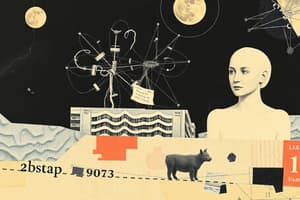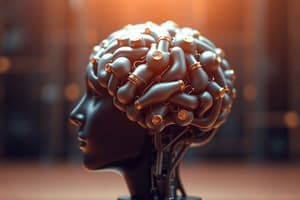Podcast
Questions and Answers
What was the main contribution of John McCarthy to the field of Artificial Intelligence?
What was the main contribution of John McCarthy to the field of Artificial Intelligence?
- He formulated the concept of 'computational rationality'. (correct)
- He created the first successful AI program, capable of playing chess.
- He devised the first practical implementation of fuzzy logic for water level control.
- He led the development of the first commercially successful AI-powered washing machine.
Which of the following is NOT a disadvantage of Artificial Intelligence as mentioned in the text?
Which of the following is NOT a disadvantage of Artificial Intelligence as mentioned in the text?
- Limited ability to adapt to unforeseen circumstances and solve problems creatively.
- Lack of emotional intelligence and empathetic understanding.
- High cost of development and implementation.
- Inability to access and process information from the real world in real-time. (correct)
What is an example of a 'knowledge-intensive task' that AI aims to solve?
What is an example of a 'knowledge-intensive task' that AI aims to solve?
- Predicting the weather based on historical data.
- Playing a simple game of tic-tac-toe.
- Diagnosing a medical condition based on patient symptoms. (correct)
- Recognizing objects in a photograph.
Which of the following scenarios BEST exemplifies the evolution of intelligent systems as discussed in 'Growth and evolution of AI - Example 1'?
Which of the following scenarios BEST exemplifies the evolution of intelligent systems as discussed in 'Growth and evolution of AI - Example 1'?
What are the primary goals of Artificial Intelligence? (Select all that apply.)
What are the primary goals of Artificial Intelligence? (Select all that apply.)
Which of the following statements BEST reflects the concept of 'computational rationality' as introduced by John McCarthy?
Which of the following statements BEST reflects the concept of 'computational rationality' as introduced by John McCarthy?
What is a potential benefit of using AI in risky areas?
What is a potential benefit of using AI in risky areas?
Which of the following is NOT a common advantage of Artificial Intelligence mentioned in the text?
Which of the following is NOT a common advantage of Artificial Intelligence mentioned in the text?
What is the primary essence of artificial intelligence?
What is the primary essence of artificial intelligence?
Which of the following is NOT a skill involved in AI?
Which of the following is NOT a skill involved in AI?
According to John McCarthy, what is a key focus of artificial intelligence?
According to John McCarthy, what is a key focus of artificial intelligence?
Why is it valuable to learn about artificial intelligence?
Why is it valuable to learn about artificial intelligence?
What differentiates AI from traditional programming?
What differentiates AI from traditional programming?
Which of the following is an example of a real-world problem that AI can address?
Which of the following is an example of a real-world problem that AI can address?
What can AI create that can assist individuals in daily tasks?
What can AI create that can assist individuals in daily tasks?
The study of AI aims to enhance machines' capability to:
The study of AI aims to enhance machines' capability to:
Flashcards
Goals of AI
Goals of AI
Main objectives include replicating human intelligence and solving complex tasks.
Advantages of AI
Advantages of AI
Benefits include high accuracy, speed, and reliability in various tasks.
Disadvantages of AI
Disadvantages of AI
Challenges include high costs, lack of creativity, and dependency on machines.
Birth of AI
Birth of AI
Signup and view all the flashcards
Definition of AI
Definition of AI
Signup and view all the flashcards
Key tasks for AI
Key tasks for AI
Signup and view all the flashcards
John McCarthy
John McCarthy
Signup and view all the flashcards
Intelligent behavior
Intelligent behavior
Signup and view all the flashcards
Simple mechanical AI example
Simple mechanical AI example
Signup and view all the flashcards
AI Techniques
AI Techniques
Signup and view all the flashcards
Fuzzy logic in AI
Fuzzy logic in AI
Signup and view all the flashcards
Problem-solving in AI
Problem-solving in AI
Signup and view all the flashcards
Real-world problems for AI
Real-world problems for AI
Signup and view all the flashcards
Virtual Assistants
Virtual Assistants
Signup and view all the flashcards
Toy Problems
Toy Problems
Signup and view all the flashcards
Impact of AI
Impact of AI
Signup and view all the flashcards
Study Notes
Unit 1: Introduction to AI
-
Artificial Intelligence (AI) is the technology capable of activities that normally require human intelligence, including learning, thinking, problem-solving, perception, speech recognition, and language comprehension. AI enables robots to simulate human cognitive processes.
-
AI is a branch of computer science that creates intelligent machines that can behave, think, and make decisions like humans.
-
AI's goals include replicating human intelligence, solving knowledge-intensive tasks, connecting perception and action, and building machines that perform tasks requiring human intelligence (e.g., proving theorems, playing chess, surgical planning, driving). AI further aims to create systems that exhibit intelligent behavior, learn, demonstrate, explain, and advise users.
AI Advantages
- High accuracy with fewer errors
- High speed
- High reliability
- Usefulness in risky areas
- Function as a digital assistant
- Useful as a public utility
AI Disadvantages
- High cost
- Limited ability to think outside the box
- Lack of emotions
- Increased dependency on machines
- Inability to generate original creativity
History of AI
-
John McCarthy researched automata theory, neural nets, and the study of intelligence at Dartmouth College, coining the term "computational rationality" for AI. The Dartmouth workshop marked a pivotal moment in AI development.
-
Key milestones in AI history include Alan Turing's test, Joseph Weizenbaum's chatbot, Sony's AIBO robot dog, Apple's Siri, Amazon's Alexa, the development of question-answering computers like Watson and GPT-3, and advancements in robotic vacuum cleaners like Roomba.
AI Growth - Example 1: Simple Mechanical Intelligent Systems
- Traditional mechanical systems, like water taps or washing machines, utilize simple sensors for decision-making. Early systems utilized an overflow method to control water flow, as illustrated in Figure 1.1.
- Further advancements introduced fuzzy logic to dynamically adjust water levels based on factors like the quantity of clothing, showing development in intelligent systems.
AI Growth - Example 2: Traffic Signals
- Traffic signal evolution from traditional, manually controlled systems to increasingly advanced computer-controlled signals, demonstrating the progressive evolution from simpler to more sophisticated AI-enabled systems, as demonstrated across time periods illustrated in Figure 1.2.
Studying That Suits You
Use AI to generate personalized quizzes and flashcards to suit your learning preferences.




